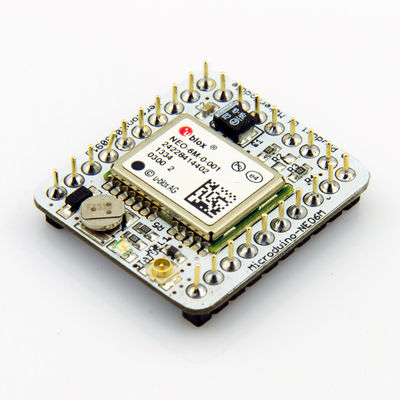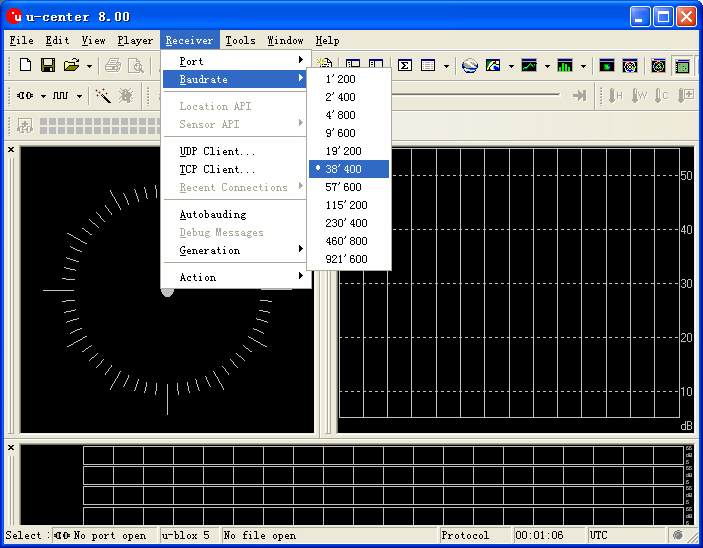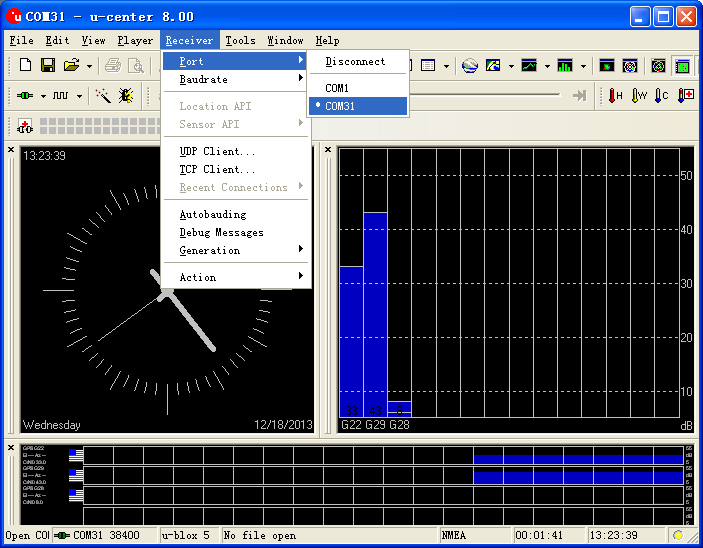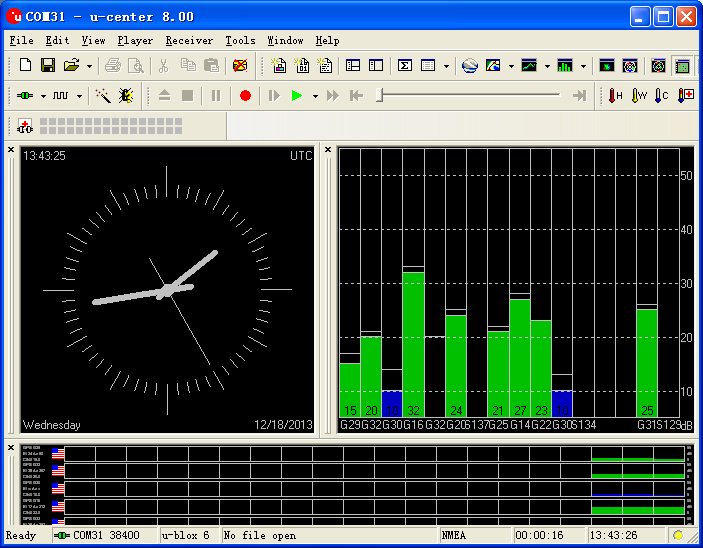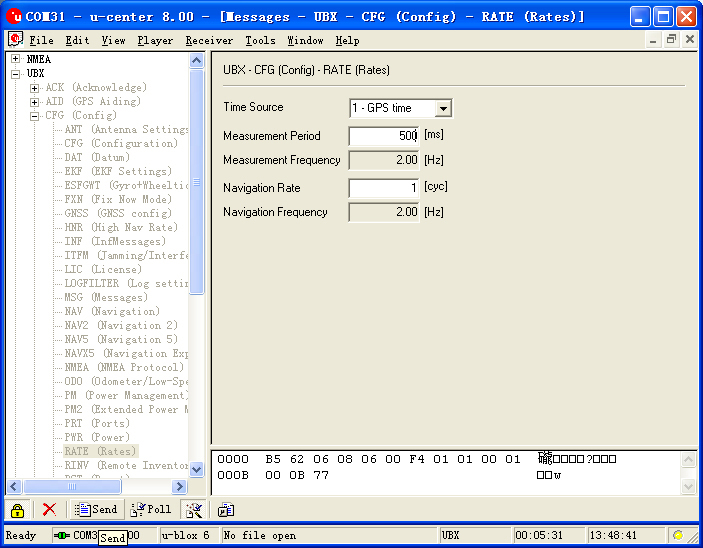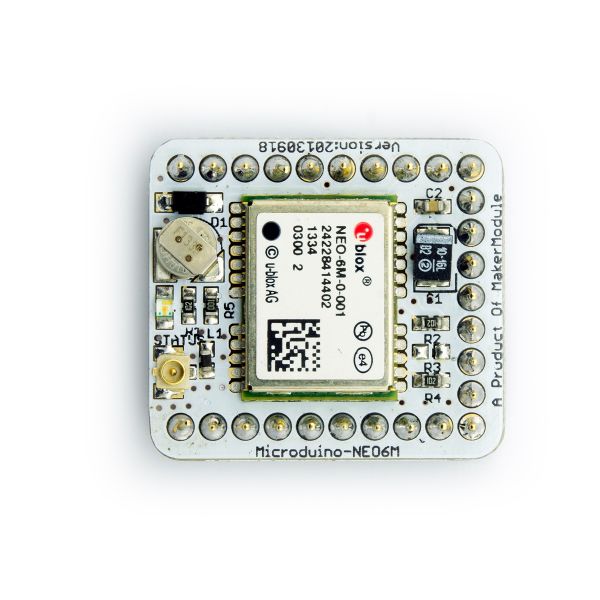Specifications
- Communication protocol:
- Microduino NEO-6M module use NMEA-0183 protocol and output GPS data, using the UBX protocol to configure the module.
- Reception characteristics
- 50 channels,GPS L1(1575.42Mhz) C/A 码,SBAS:WAAS/EGNOS/MSAS
- Capture tracking sensitivity:-161dBm
- Capture time
- cold start:27S(Fastest time)
- warm start:27S
- hot start:1S
- Note:
- Cold start means that module stored history information which GPS receiver has lost (corresponding to the main power supply and battery both lost power), then restart the module, called cold start.
- Warm start means that the is the module saved the historical information, but this information is inconsistent with information of currently visible satellites, and under such conditions to start module, called warm start.
- Hot start means that module stored GPS history information which consistent with the currently visible satellite's information, then restart the module, called a hot start.
- Interface characteristics
- TTL,compatible 3.3V/5V microcontroller system
- Serial communication baud rate:
- Microduino NEO-6M module supports several baud rate:4800,9600,38400(defult),57600;
- Set the baud rate by two resistors (R3,R4,recommend value is 1k):
| R3 |
R4 |
Protocol |
Baud rate
|
| No welding |
No welding |
NMEA |
9600
|
| No welding |
welding |
NMEA |
38400
|
| welding |
No welding |
NMEA |
4800
|
| welding |
welding |
UBX |
57600
|
Pin Description
| NEO-6M Module Pin |
Microduino Pin |
Function
|
| TX |
RX0(or D2) |
Module serial send pin (TTL level), connect to microcontroller's RXD
|
| RX |
TX1(or D3) |
Module serial receive pin (TTL level), connect to microcontroller's MCU TXD
|
Document
Eagle PCB 文件:Microduino-NEO6M.zip
Main components
Development
- Make sure the +3.3 v power supply current can reach 200ma, not recommended use FT232R debugging directly, because FT232R's output +3.3 v current is too small.
Arduino library and supported package
How to use the library
- For Adafruit_GPS library:
- Make sure the GPS baud rate is 38400 in function "void setup()",that is:GPS.begin(38400);
- If you don't change the jumper cable:
- Unplug the Microduino NEO-6M module when downloading program;
- Use the Core or Core+ to debug, make sure include "Adafruit_GPS GPS(&Serial)" in program;
- If you have changed the jumper cable:
- When use Core+ to debug,make sure include "Adafruit_GPS GPS(&Serial1)" in program;
- When use Core to debug, make sure include "SoftwareSerial mySerial(3, 2)" and "Adafruit_GPS GPS(&mySerial)" in program;
PPS State indicator
- This indicator connects to TIMEPULSE port on UBLOX NEO-6M module, the output characteristic can be set by program;
- PPS indicator has two state as default value without program setting:
- Keeping on,indicates that module has started, but but have not yet achieved positioning;
- Flicker,(100ms off,900ms on),indicates that module has achieved position successfully.
- Easy to identify the state of module by PPS indicator.
Application
Download program
Tesp Program:文件:Program Test NEO-6M.zip
Test Microduino NEO-6M using FT232 and core module
- Prepared hardware:Microduino FT232R、Microduino Core、Microduino OLED、Microduino NEO-6M;
- Prepared software:Arduino IDE(1.0 release upper)、Adafruit_GPS library、Microduino provides test program(Arduino part);
- Test environment:Open area,don't test in root;
- Put the downloaded library to the libraries folder of Arduino IDE installation fold;
- Start Arduino IED,open the test program,card type chooses "Microduino Core (Atmega328P@16M,5V)",download directly;
- Use the default jumper pin (RX0,TX1):
- Unplug the Microduino NEO-6M module when downloading program;Microduino NEO-6M module has the same RX0/TX1 pin position with Microduino FT232R, if superimpose these two module directly, the download process will be impact.
- After finished download, then superimpose the NE0 modult the core module and FT232 module again.
- Observed the OLED after the download completed:
- After half of minute,display data and time;
- Go on waiting,when you see PPS indicators of Microduino NEO-6M flashing, then the speed, latitude and longitude indicators can be displayed,if not, please restart Microduino Core.
- Player changes the back jumper cable:Cut off the connection between the middle of bonding pad and RX0/TX1, then welding the middle of bonding pad to D2 and D3. The purpose of change jumper is download program easily. Once changed the jumper, you superimpose three board together to download program.
- If you use the change jumper connection method, it will change the serial connection from TX-RX0,RX-TX1 to TX-D2,RX-D3 between Microduino NEO-6M and Core module.
Test Mocroduino NEO-6M using PC
Connection method
There are two connection methods:
1. Use the default pin (RX0、TX1):
- You need the Microduino FT232R module to connect the PC, but can't superimpose the FT232R, NEO-6M and Core module directly. Because the FT232 and NEO-6M has the same RX/TX defination and position on board, but the normal serial communication should be cross connect RX/TX.
- Superimpose the FT232 and microduino core, then conects to PC with microUSB to download program;
- Using the jumper cable cross connect the RX0/TX1 for FT232 and NEO-6M, that is the RX0 of NEO-6M connects to the TX1 of FT232, and the TX1 of NEO-6M connects to RX0 of FT232.
- Connect the 3V3 pin of NEO-6M module to 3V3 pin of FT232, and connects the GND together.
2. Use the changed jumper mode
If you have changed the jumper as upper described, you can supperipose FT232, NEO-6M and Core module together, then connect to PC to debug directly.
Use u-center configuration module to update rage
- Firstly, place the Microduino NEO-6M into an open area, and then connects to PC by Microduino FT232R;
- Start "u-center" software:
- Set the baud rate:Menu:“Receiver”-“Baudrate”-“38400”;
- Open the serial to start the communication:Menu:“Receiver”-“Port”- choose the port that Microduino FT232R using.
- Now,you can see the data on the "u-center";
- Update rate
- Open menu:“View”-“Messages View”,display the "Messages" window;
- Open“UBX”-“CFG(Config)”-“RATE(Rates)”,suppose you need 2HZ update rate, only need set the "Measurement Period" to 500ms;
- After configured,click the "Send" button on the left bottom to send the configuration to Microduino NEO-6M module. If you see the data update quickly on other information window, that means the set successfully.
Bug
History
Picture
Video
|
